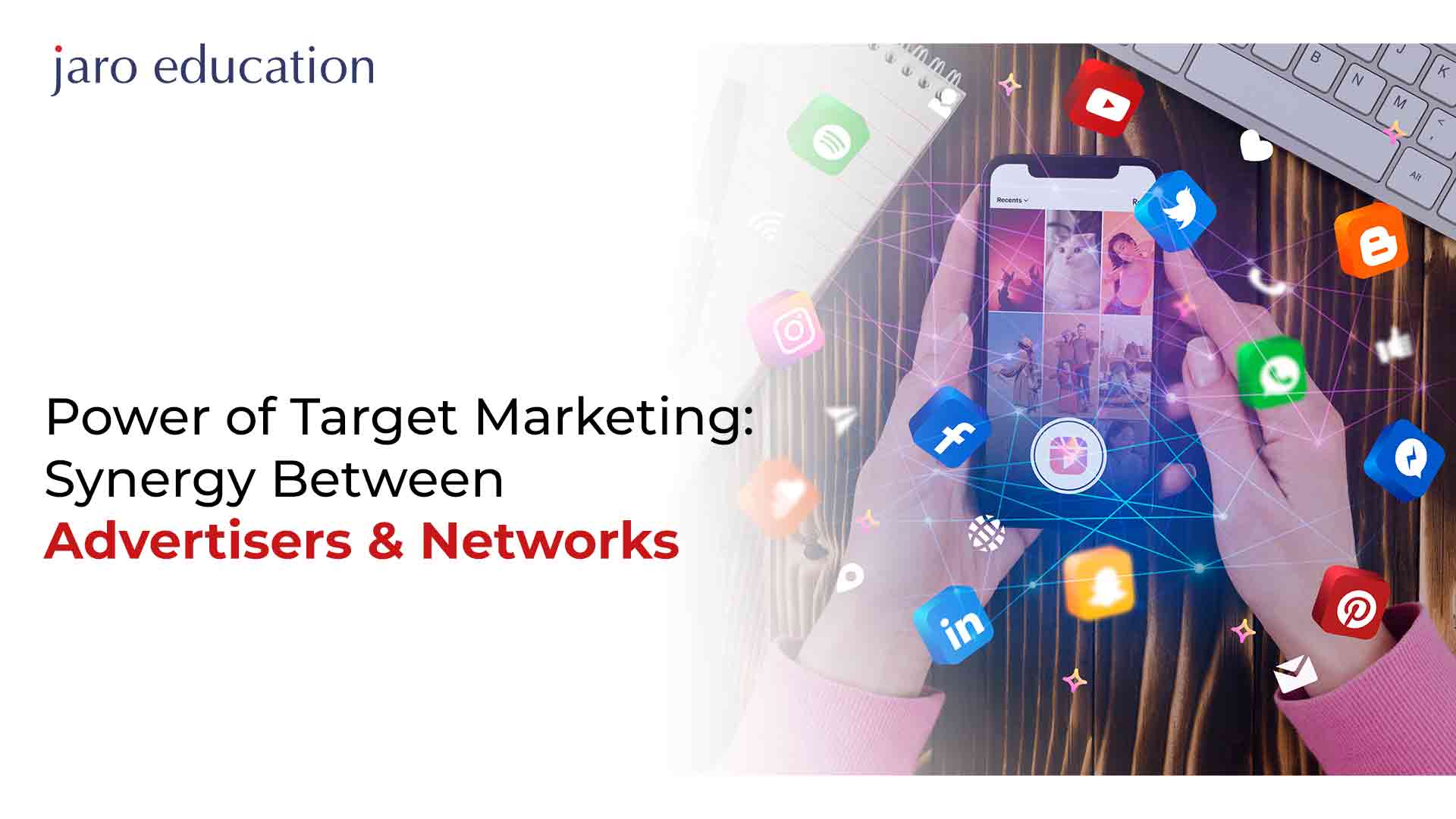
- jaro education
- 9, January 2024
- 11:04 am
In the diverse market space, not every product aims to capture a universal audience. Understanding to whom a product will appeal and who is likely to purchase it is crucial for success. User bases can grow over time through additional marketing, digital advertising, word of mouth, so on and so forth. This is exactly why businesses invest time and resources in defining their initial target markets and follow through with special offers, social media campaigns, and specialized digital advertising to effectively connect with their audience.
A significant portion of Meta’s annual revenue, amounting to $117 billion, is derived from targeted advertisements. Targeted ads, in general, exhibit notably higher effectiveness, with up to a 5.3 times increase in Click-Through Rates (CTR), signifying the importance of target marketing.
This blog explores target marketing’s fundamental concepts, real-world applications, and the symbiotic relationship it shares with the evolving realms of digital marketing.
What is Target Marketing
A target market is a specific group of potential customers that a business aims to connect with through its products or services. This group shares common characteristics like age, gender, income, education, interests, or location, making them more likely to be interested in what the business offers.
Table of Contents
Defining a target market is a crucial step in making a successful marketing plan. Target Marketing helps companies focus on people who are most likely to become customers. By tailoring their messages, products, and prices to suit the unique needs and preferences of this target market, businesses can boost sales and profitability.
For example, think about a store that sells women’s clothing. By figuring out specific age groups, income levels, and where people live, the store can precisely reach potential customers and this is what Target Marketing is. It allows the store to offer clothing choices that match their preferences, creating a stronger connection with the audience and increasing overall success.
How Target Marketing Works
Target marketing works like magic by focusing on specific groups of consumers, making marketing efforts more effective, cost-efficient, and focused. Whether it’s adjusting promotions, pricing strategies, or where products are sold, this approach makes marketing activities more straightforward.
Imagine a catering business that provides services in people’s homes. Instead of advertising to everyone through a broad newspaper insert, the business identifies its target market and creates campaigns like direct mail, local flyers, or Facebook ads. This precision not only helps get more out of marketing efforts but also attracts a more relevant customer base.
Social media platforms with advanced targeting tools include Instagram, Twitter, Facebook and LinkedIn. For example, a bed-and-breakfast company could use Facebook to promote romantic getaway packages to its married followers. LinkedIn, more focused on business, allows targeting based on location, industry, and company size.
Thus, mastering the essentials of digital marketing skills is required for individuals to enhance and broaden their perspectives in target marketing in the new age world. IIM Ahmedabad’s Digital Marketing: Business Models, Processes, and Technologies course serves as a valuable resource for aspiring leaders. By participating in this program, individuals can elevate their capabilities and establish themselves as strategic leaders in the digital marketing space.
How to Define a Product’s Target Market?
Defining your product’s target market is an integral part of the product development process. When creating a new product, it’s essential to identify the specific group of consumers who will find it appealing and beneficial.
A new product is typically designed to address a particular need or solve a specific problem that is relevant to a subset of consumers, such as environmentally-conscious vegetarians, science enthusiasts, or outdoor lovers. However, the product still may have potential appeal to various demographics, including teenagers, middle-aged professionals, bargain hunters, or individuals with a penchant for exclusivity.
So, developing a clear picture of your target market is essential to the development and improvement of your product. It directs choices about product placement, marketing tactics, and packaging, making sure your product effectively reaches the target market.
Types of Target Markets
Market segmentation, a pivotal aspect of effective target marketing, unfolds through various dimensions, providing businesses with nuanced perspectives to connect with their audience. Let’s delve deeper into the primary types:

*waypointmc.com
1. Demographic Segmentation
Categorizing the market based on demographic attributes such as age, gender, income, education, and occupation. For instance, a fitness brand like Nike might strategically target a demographic of young, health-conscious individuals by tailoring its marketing messages and product offerings to align with their preferences.
2. Psychographic Segmentation
This approach involves understanding consumers’ lifestyles, values, interests, and personality traits. Imagine a luxury brand such as Rolex focusing on psychographic segmentation by targeting consumers who prioritize exclusivity and prestige. The marketing strategies are then tailored to resonate with their aspirational lifestyles.
3. Behavioral Segmentation
Analysis of consumer behavior plays a crucial role, considering factors like buying patterns, product usage, and brand loyalty. A subscription-based streaming service like Netflix provides a real-world example, using behavioral segmentation to tailor content recommendations based on users’ viewing history and preferences, thereby enhancing user engagement.
4. Geographic Segmentation
Guided by geographical factors like region, climate, and population density, this segmentation approach influences marketing strategies. An ice cream brand like Ben & Jerry’s provides a tangible example, adjusting its campaigns based on geographic segmentation. For instance, promoting refreshing flavors in warmer regions and warm indulgences in cooler climates.
By applying these segmentation methods, businesses can craft targeted marketing strategies, ensuring resonance with specific consumer groups and maximizing the impact of their outreach efforts.
Real-World Example of Target Marketing
The real-world examples offer insightful glimpses into effective strategies that resonate with diverse consumer segments. Examining how industry leaders employ target marketing provides valuable lessons for businesses aiming to connect with their audience in a meaningful way.
Starbucks
Starbucks, a global coffeehouse chain, employs sophisticated target marketing strategies. One notable example is their focus on psychographic segmentation.
Psychographic Attributes
Starbucks caters to a diverse range of customers with varying lifestyles and values. One key psychographic segment they target is the ‘Urban Professional.’ This demographic includes individuals with busy, on-the-go lifestyles, a penchant for quality coffee, and a willingness to pay a premium for a premium experience.
Tailored Marketing Approach
Starbucks tailors its marketing messages and store ambiance to resonate with this segment. They emphasize the quality of their coffee, offer convenient mobile ordering options for busy professionals, and create a cozy atmosphere within their stores to attract those seeking a comfortable space to work or socialize.
Product Innovation
The introduction of the ‘Pumpkin Spice Latte’ during the fall season is another strategic move. This seasonal offering capitalizes on the psychographic preference for unique and trendy experiences, creating a sense of exclusivity and anticipation among their target audience.
Dove
Dove, a personal care brand, employs a unique approach known as ‘Real Beauty’ in its marketing, focusing on psychographic and behavioral segmentation.
Psychographic and Behavioral Attributes
Dove targets individuals who appreciate authenticity and inclusivity. Their ‘Real Beauty’ campaign challenges traditional beauty standards, appealing to those who seek products aligned with a positive self-image. The brand also emphasizes a ‘cruelty-free’ approach, appealing to consumers with ethical and environmental concerns.
Tailored Marketing Approach
Dove emphasizes true beauty in a range of shapes, sizes, and ethnicities through the use of diverse models in their marketing materials. Customers looking for ethical and sustainable personal care products will find their dedication to using ingredients sourced responsibly and refraining from animal testing to be in line with their values.
Consumer Connection
By connecting with consumers on a deeper level and challenging societal norms, Dove builds a loyal customer base that values authenticity and ethical practices in the beauty industry.
Peloton
Peloton, a fitness technology company, utilizes a combination of psychographic and behavioral segmentation.
- Psychographic and Behavioral Attributes
Peloton targets individuals who are passionate about fitness, seek convenience, and value a sense of community. Their approach caters to people who prefer working out at home but still want an engaging and connected fitness experience. The brand taps into the behavioral aspect of customers who prioritize health and fitness in their lifestyle.
Tailored Marketing Approach
Peloton’s target marketing revolves around promoting its interactive and immersive home fitness solutions. The brand emphasizes the convenience of having access to live and on-demand classes, fostering a sense of community through virtual connections. Their marketing materials often feature individuals who are dedicated to fitness and value the holistic experience that Peloton provides.
Brand Loyalty
By understanding the psychographic and behavioral traits of its target audience, Peloton has successfully created a loyal community of fitness enthusiasts who appreciate the brand’s emphasis on connected and convenient workout experiences.
These real-world examples showcase the effectiveness of target marketing strategies employed by industry leaders. As professionals seek to enhance their digital marketing skills, the “Digital Marketing: Business Models, Processes, and Technologies” course by IIM Ahmedabad emerges as a transformative resource.
Difference Between Target Market vs. Target Audience
While often used interchangeably, “target market” and “target audience” refer to distinct groups within the realm of marketing. They carry distinct meanings and cater to different aspects of consumer engagement.
| Criteria | Target Market | Target Audience |
|---|---|---|
| Definition | The overall group of people a business aims to reach through its marketing efforts. | A specific subset of the target market that a company tries to reach through targeted marketing efforts. |
| Scope | Encompasses a broad range of potential buyers with varied characteristics. | Focuses on individuals with shared characteristics within the broader target market. |
| Size | Larger and more extensive, covering a wide demographic spectrum. | Smaller and more defined, representing a specific segment of the target market. |
| Customization | Marketing strategies are designed to appeal to the diverse interests of the overall market. | Tailored marketing strategies address the unique needs and preferences of a specific group. |
| Messaging | Broad and general messages that highlight the overall benefits of the product or service. | Specific and targeted messages crafted to resonate with the identified subset's interests or concerns. |
| Example Scenario | A tech company launching a versatile smartwatch with features appealing to a diverse demographic. | The same tech company emphasizing health-tracking features to attract an older audience of health-conscious consumers. |
| Objective | Broadly introduce products or services to a wide audience. | Achieve higher engagement and conversion rates by focusing on a more receptive and specific segment. |
| Marketing Channels | Utilizes various channels to reach a wide audience, such as mass media and general digital advertising. | Targets specific channels that resonate with the identified subset, such as niche publications or platforms. |
| Demographic Range | Encompasses a wide range of demographics, including age, gender, income, and location. | Narrows down to specific demographics based on shared characteristics relevant to the marketing goals. |
| Flexibility | May require more flexibility in marketing strategies to appeal to diverse interests. | Allows for more precise and adaptable marketing approaches tailored to the identified group's preferences. |
Final Words
Target marketing‘s potency stems from its capacity to speak directly to the emotions and thoughts of particular consumer segments. Businesses can improve the efficacy of their marketing, forge closer bonds with clients, and eventually drive success in the cut-throat industry by identifying their target audience and developing strategies accordingly. Also, in most business scenarios, Target marketing’s efforts are maximized by the harmonious dance created by the strategic alliance between networks and advertisers.









